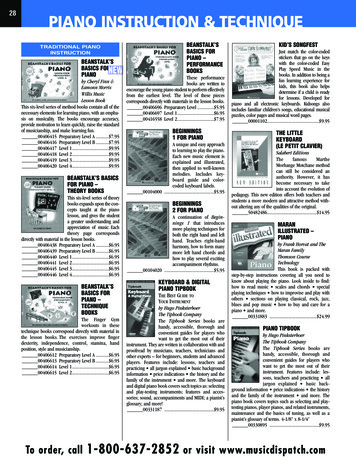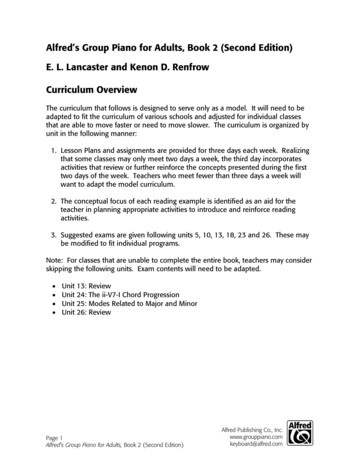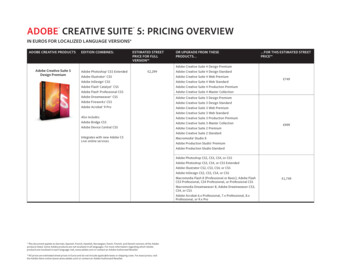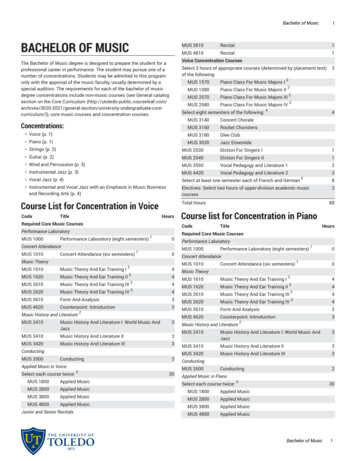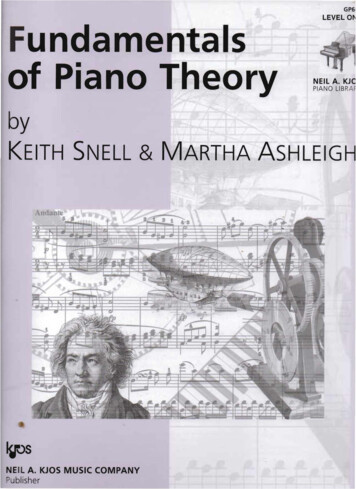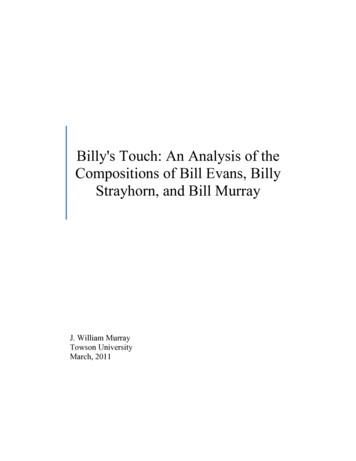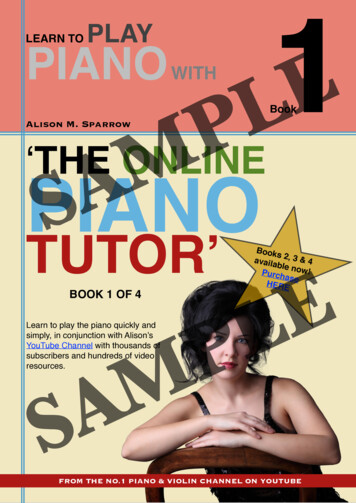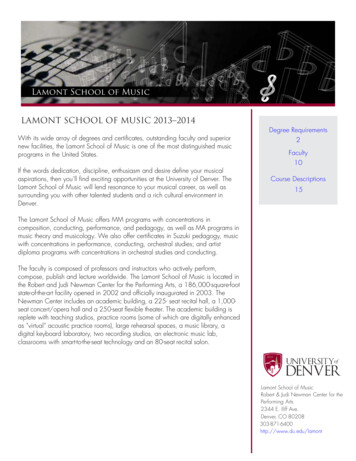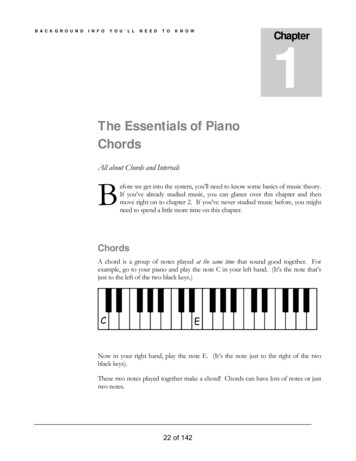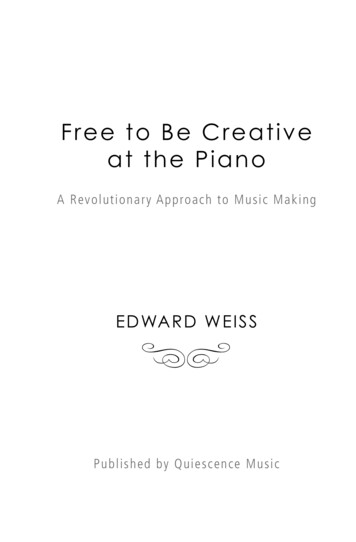
Transcription
Free to Be Creativea t t h e P ia noA R e v o l u t i o n a r y A p p r oa c h t o Musi c MakingED WA R D W E IS SabP u b l i s h e d b y Q u i e s c e n c e Musi c
Copyright 2010 Edward Weiss, Quiescence Music. Allrights reserved. No portion of this book may be reproducedmechanically, electronically, or by any other means, including photocopying, without written permission of the author.It is illegal to copy this book, post it to a website, or distribute it by any other means without permission from theauthor.Limits of Liability and Disclaimer of WarrantyThe author and publisher shall not be liable for any misuseof this material. This book is strictly for informational andeducational purposes.Warning – DisclaimerThe purpose of this book is to educate and entertain. Theauthor and/or publisher do not guarantee that anyone following these techniques, suggestions, tips, ideas, or strategies will become successful. The author and/or publishershall have neither liability nor responsibility to anyonewith respect to any loss or damage caused, or alleged to becaused, directly or indirectly by the information containedin this book.
Table of ContentsComposition .15A Quick and Easy Composition Method .17Beautiful Music Create It Yourself with New Age Piano .18Compose Music the Easy Way! .19Composing For Piano - Don’t Force, Allow .20Composing George Winston Style .22Composing Music - A New Approach .23Composing Music - How To Compose A Theme andVariations for Piano .24Composing Using Chord Charts .25Composing Your Own Music - Easier Than You Think 26Composing for Piano - Learn How to Improvise First! .27Composing for Piano Using Small ABA Form .28Creating Stark Atmospheres .29Creating Within Limits .30Creating Your Own Compositions .31Creating Your Own Unique Music .32Creative Dry Spells and What to Do About Them .33Don’t Be Afraid of Melody .34Everything I Play Sounds the Same .35How I Compose a Piece of Music .36How To Compose Your First Piano Piece .38How To Create An Original Melody From Scratch .39How To Create a Solo Piano CD A Step by Step Approach! .41How To Use Piano Chords To Create Complete SectionsOf Music .42How to Arrange Music for Piano .44How to Capture a Mood Using a Few Chords .45a3b
How to Compose Using ABA Form .46How to Compose Your Own MusicUsing 8-bar Phrases .47How to Create Interesting Textures .49How to Create Your Own BeautifulPiano Compositions .50How to Create Your Own Piano Compositions Quicklyand Easily! .51How to Create a Theme and Variations for Piano! .52How to Create an Original Melody .54How to Find Musical Ideas .55How to Get Past Creative Blocks .56How to Quickly and Easily Block out Entire Sections ofMusic .57How to Use Chord Changes to Learn the Art ofMusical Composition .58Musical Composition - How To Listen To Music Like AComposer .59New Age Pianist Shows You How To Compose YourOwn Music .61New Age Piano Tricks .62Paint Your Own Musical Landscapes! .63Piano Composition Secret of George Winston RevealsEasy Way to Play Piano! .64Piano Journeys -Create Your Own Unique Music! .65Piano Lessons:Creating an Impressionistic Soundscape .66Piano Songs - Create ThemYourself With Just a Few Chords! .68Piano Songs - Create Them Yourself! .69Play and Compose New Age Piano Now - Even if You’veNever Touched a Keyboard! .70Relaxing Piano Music - Create It Yourself With TheseEasy to Follow Piano Lessons .72a4b
Simple ABA Form - Creating Your Own PianoCompositions! .73The Secret to Composition .74To Learn How to Compose, .75Learn How to Improvise .75You Can Compose Your Own Music! .76Improvisation .79Avoid These 3 Common Mistakes When Improvising .81Create A Fantastic Sounding Piano Improvisation UsingJust One Chord! .82Creating A Piano Improvisation - The Making of December Twilight .83Creating “Caverns” - an Improvisation Exercise .84Creating a Broken Chord Piano Improvisation .85Creating a Free-Form Piano Improvisation .87Creating a Timed Piano Improvisation! .88Creative Piano Playing 101 .89Deep Piano - How To Go Beyond Surface Playing .90Easy Piano Improvisation:Learn to Express Yourself! .91Easy Piano Improvisation .93Strategy Lets You Play With .93Freedom and Confidence .93Five Minute Piano Improvisation Reflections in Water .94Free Online Piano Lesson Shows You How To ImproviseStep by Step .95Free Piano Lesson, .97“Reflections in Water,” .97Shows You How To Improvise! .97Free To Be Creative at the Piano .98How To Quickly AndEasily Improvise Your Own Unique Piano Music! .99a5b
How to Be in the Moment When Playing Piano .101How to Improvise Freely On Piano! .102How to Improvise Using a Few Chords .103How to Improvise a Complete Piano Piece Using Just 2Chords! .104How to Make Your Boring Piano Improvisations Come toLife! .105How to Play Like George Winston .106How to Play What You Feel .107How to Stop Thinking and Start Playing .108How to be Creative at the Piano .109Improving Your Improvisation Skills .110Improvisation Practice .111Improvisation and Musical Form .112Improvisation is About Feeling .113Instant Piano: A Quick Tip For Creating GreatSounding Improvisations! .114Keys to Successful Piano Improvisation! .116Learning How To Improvise .117Monterey Beach - An Improvisation Exercise .119Music Without Goals .120New Age Piano and Improvisation .121Piano Chords For New Age Piano .122Piano Improvisation - Easier Than You Think! .123Piano Improvisation Journeys Create Your Own Unique Music! .124Piano Improvisation Tips - Enjoy the Process First! .125Piano Improvisation UsingLeft Hand Ostinato Patterns .127Piano Meditations: A Beginner’s Guide to Playing WhatYou Feel .128Piano Music, Perfectionism, and Self-Expression .129Reflections in Water A Piano Improvisation Exercise .131a6b
Successful Black Key Improvisation .132Taking the Mystery Out of Improvisation .133The Freedom To Explore At The Piano .134The Joy of Spontaneous Expression .135The Key to Creating Fresh SoundingPiano Improvisations .136The Most Beginner-Friendly Way to Improvise .137The Secret to Fresh Sounding Improvisations .138Top 7 Don’ts for Successful Improvisation .140Top 7 Do’s for Successful Improvisation .141What Works Best in New Age Piano Improvisation .142Why Learning How to Improvise is So Important .143You Can Create Your Own Music - Even If You’veNever Touched a Piano In Your Life! .144You Can’t Force Play .146Learning.147Adult Piano Lessons - How to Begin .149Beginners Piano Lessons Should be Exciting .150Computer Piano Lessons And Why You ShouldConsider Taking Them .151Creative Piano Instruction - Does it Exist? .152Creative Piano Lessons for the Absolute Beginner .154Edward Weiss’s Piano Playing Secrets .155George Winston and David Lanz - Learning How to PlayLike Them .157Get Piano Lessons Right on Your Computer! .158Good News for the Musically Untalented .159How a “Difficult” Piano Student Actually Showed MeHow to Teach Piano .160How to Make Your Piano Playing Come Alive.Without Using Any Hype! .161How to Play Piano Using a Few Chords .163How to Play Piano in Less Than One Hour! .164a7b
Keyboard Lessons - Simple, Fast, and Focused! .165Learn How to “Speed Listen” in a Few Easy Steps! .167Learn Piano Fast - Even if You Don’t Know WhereMiddle C is! .168Learn Piano Online and Save Time .170Learn and Play Piano Now WithThis Easy to Use Technique! .171Learn How to Use ChordsLearning Piano Without Years of Lessons! .172Learning Piano by Listening to Other Pianists .173Learning the Piano and Playing the Piano .175New Age Piano Lessons Give YouInstant Satisfaction on the Keyboard! .176New Year’s Resolutions - Play Piano! .177Online Piano Lessons - Are They For You? .179Painting with Sound .180Piano For Beginners - An Easy Way to Play! .181Piano Keys And How To Make Sense Of Them .182Piano Lesson Books The Only One You’ll Ever Need! .183Piano Lessons Can Be Fun! .185Piano Lessons For Beginners - A New Approach .186Piano Lessons Outside the Box:A New Approach to Learning Piano .187Piano Lessons and Perfectionism .188Piano Lessons for Seniors - Now Online .190Piano Right From the Start: “Learning to Play What YouFeel!” .191Piano Teachers - What’s Wrong with Them? .192Piano Teachers And How To Choose One That’s RightFor You .193Piano Tutors and Why You Might Need One .195Piano on the Right Side of the Brain .196a8b
Play Keyboards Instantly With ThisEasy To Use Chord Technique! .197Play Piano Instantly -Even If You Don’t Know WhereMiddle C Is! .198Playing Piano - A Whole New Approach! .200Private Piano Lessons - Are They a Waste of Time? .201Self-Expression Without Criticism .202Stop Playing Piano the Hard Way! .203Teach Yourself How To Play PianoDespite Years Of Lessons .204The Case Against “Traditional” Piano Lessons .206The Most Important Thing a Piano TeacherCan Give You .207Who Else Wants To Play New Age Piano? .208Why Most Piano Teachers Can’t Help You Create YourOwn Music! .209Why Playing the Piano Can Be a Chore and What to DoAbout It .210Why Playing the Piano by Ear Can Slow You Down Creatively .211Why You Can’t Play Piano .212Why You Still Can’t Play the Piano .213Why a Guitar Player Can Teach You More About PianoThan a Piano Teacher .215Performing.217Common Thoughts That Kill Inspiration .219Piano Playing and Performance Anxiety .220Sharing Your Music With Others .222Simple Piano Playing Tip Lets You Breathe New LifeInto Your Music .223Tips on Performing Your Music for Others .224Trusting Your Inner Voice Key to Success at the Piano .226a9b
Style .229An Easy Way to Get the New Age Sound .231Arranging for New Age Piano .232Bob Ross - Art Teacher Extraordinaire! .233Classical Piano Lessons What to Do When You Finally Get Tired of Them 234Digital Pianos - Are They Right for You? .235Empty and Marvelous .236Five Secrets to Playing in the New Age Style .237George Winston andNew Age Piano Playing .240Music Making as Spiritual Experience .241Music Therapy and New Age Piano .243Nature Sounds and New Age Piano .244New Age Music - How It’s Made .245New Age Music - What Is It Good For? .247New Age Piano: Capturing the Beauty of Nature .248New Age Piano Music - My Top Picks .249New Age Piano Music and Those Who Hate It .251Piano Class Very Unsatisfactory .252Play Piano in the New Age Style .253Pure Moods: Playing New Age Piano .254Reduce Stress Through New Age Piano .255Relaxation Music and New Age Piano .256Should Music Be Used for Something? .257Showing Up at the Piano .258Six Reasons to Play New Age Piano .259Stress Relief and Music .260The 2 Styles of New Age Piano Playing .261The Artist’s Way Meets the Piano .262The Beauty of New Age Piano .264The Flower Garden and New Age Piano Music .265The Horror of Traditional Piano Lessons .266a 10 b
The Magic of New Age Piano .267The New Age Piano Style - What Does It Offer? .268The Simple Joy Of New Age Piano Playing .269What Happened to New Age Piano? .270What is New Age Piano Anyway? .271Zen and the Art of New Age Piano .272Technique .275Amazing Technique for New Age Piano Lets You CreateRich Harmonic Backgrounds .277Arpeggios and New Age Piano Playing .278Basic Piano Lessons - Introducing The Open PositionChord .279Beyond the Open Position Piano Chord .280Breakthrough Chord Structure Makes Playing Piano aBreeze! .281Breathing Space in Music .283Broken Chord Piano Technique:“What It is and How to Use It” .284Chord Piano - An Easy Way to Begin .285Chord Progressions for New Age Piano .286Czerny, Finger Exercises, and Piano Playing .287Extremely Simple Way to Play What You Feel on thePiano - Even if You’ve Never Played Before! .288George Winston Music - Create it Easily Yourself! .290How to Figure Out What Another Pianist is Doing .291How to Jump Chords Up the Keyboard to Create a .292Free-Flowing Sound! .292How to Quickly Play Piano Using the Incredible OpenPosition Chord! .294How to Use the Entire Piano Keyboard .296It’s Easy to Create Melody! .297Just 3 Chords? No Way! .298Learn Piano Chords The Easy Way! .299a 11 b
Learn to Play the Piano FastWith This Cool Technique! .300Left Hand Patterns for New Age Piano .302Left Hand Ostinato Patterns and Why They’re Perfect forPiano Improvisation! .303Modal Improvisation - An Easy Way To Get Started! .304More Right Hand Techniques For New Age Piano .306More Right-Hand Techniques for Piano Players .307New Age Piano Playing and the Sustain Pedal .308New Age Piano Techniques: Creative and Easy! .309Open Position Piano Chords - Perfect for the New AgeStyle .310Perfect Pitch: Is it Really Necessary? .312Piano Chord Changes and How to Chart Them Out .313Piano Chord Charts and How to Use Them .314Piano Chords and New Age Music .315Piano Improvisation Techniques:Creating The Arpeggio .316Piano Instruction It Doesn’t Have to be a Chore for You! .318Piano Keyboards and How to Use Them .319Piano Lessons for the Creatively Challenged! .320Piano Music - How to Begin and End a Piece .321Piano Notes - How To Achieve Hand Independence onthe Piano .323Piano Playing Tips for The Creatively Impaired .324Piano Tabs - Who Needs Them? .326Piano for the Fun of It: Creating with the Open PositionChord .327Play Chord Piano FastWith This Easy To Use Technique! .329Play Chord Piano Now - Even If You Don’t Know Majorfrom Minor! .330a 12 b
Play New Age Piano Now With ThisEasy to Use Technique .331Play Piano By Ear In Less Than One Hour! .332Right Hand Techniques for New Age Piano .334The Crossover Technique and How to Use It .335The One Piano Playing Technique That MakesEven Tone Deaf Students Sound Good! .336The Only Piano Book You’ll Ever Need .337The Open Position Piano Chord .338The Ostinato - What It Is and How to Use It .339The Piano Keyboard and the Open Position Chord .340a 13 b
a 14 b
Compositionaba 15 b
a 16 b
A Quick and Easy CompositionMethodHere’s the method I use every time I want to capture anidea. I draw out 8-bars (or measures) first. Why eightbars? Because it is an ideal framework to work in.Eight bars of music are enough to generate a complete musical sentence and can usually be repeated once or twice. Next,I improvise and see what comes up. THEN, I will write downthe chords I am playing and the first 2-bars of melody.Writing down the first 2-bars of melody helps me remember the entire theme for the 8-bar phrase. I usually stay withinone key to make it easy. This means I’ll have 6 chords to workwith. In C Major, the chords would be, C Maj. -D min. -Emin. -F Maj. -G Maj. and A min. This is more than enoughmaterial to work with. In fact, I rarely use more than 3 or 4chords for the first 8-bars.Once you get your first 8-bars down, you’re more thanhalfway home. Why? Because you already have the beginning. The rest of the piece, if there is a rest of the piece, can befinished by drawing more bar lines AND LISTENING FORTHE NEXT SECTION OF MUSIC. This is always accomplished through improvisation.Your best material will ALWAYS come from improvisation because you are not thinking about creating something.a 17 b
Instead, you are allowing the music that is inside of you tocome to the surface without forcing it or willing it into being.You use the 8-bar framework to hold your ideas.There is no rule that says you must work within 8-bars.You can use four or even sixteen bar phrases, however, itsgood to be able to feel the form and structure of an 8-barphrase first. It is the structure used by most composers and itis wise to understand it.abBeautiful Music Create It Yourself with New AgePianoYou’ve heard it many times before. Perhaps while you wereout shopping or at a friends house. The beautiful musicthat has become known as New Age piano was first popularized by pianist/composer George Winston in the early 1980’s.Light and heartfelt, the melodies and chords of this pianostyle are not difficult to create. It’s an attractive way for thebeginning AND more advanced piano player to get started inmusic making! Let’s examine how a complete beginner cancreate a lovely melody using just a few chords.First, we must learn how to play chords on the piano.Note reading won’t do here because we’re trying to createsomething original -something that requires the ability toimprovise. Now don’t get scared! Improvisation is a lot easierthan you think and you can produce beautiful music withjust a few chords.a 18 b
For example, in the lesson “Reflections in Water,” available below, we use just 4 chords to create a calm, reflectiveatmosphere. The trick is how the chords are used! Bothhands are called into play as we create a modern soundingopen position seventh chord - the kind of chord that is usedin much contemporary music created today.We learn how to play just four chords in this lesson, butfour chords are all we need to produce a few minutes of improvised music. Once you have this large chord structure underyour fingers, beautiful music is created; not by forcing or willing the creative act, but BY ALLOWING IT TO HAPPEN!We take our time and play around with this chord structure and marvel at how easy it is to create music with it. It’snot difficult. It’s not hard. It can be a little scary to jump inand begin improvising but once you taste how wonderful thewater is, you’ll jump in and have a hard time coming out!abCompose Music the Easy Way!There are basically two ways to compose music. One wayis by starting from the bottom or the harmonic approach.A composer/arranger takes a few chords, a phraseto hang them on and arranges the harmony in some kindof pattern. An example of this is the “loop” you often hearin contemporary music. A loop is simply a harmonic background over which a melody (or not) is played.The second way to compose music is by starting with themelody. Composers may or may not have some idea of thefinished idea (I prefer not to) but the melodic idea is fitteda 19 b
into some kind of phrase. The most common phrase used isthe 8-bar phrase.I find that starting with the melody to be the easierapproach. Why? Because melody is easier to move forwardthen harmony. Sure, you can block out a few chords andarrange them to create a loop, but this becomes static overtime. Melody is much easier to go forward with.By using the principles of repetition and contrast, we cancreate a simple ABA form in no time at all. Then we can goback and harmonize each section.I used to favor the harmonic approach at first. It was veryeasy to simply jot down chord changes on an 8-bar phrase,create some kind of arrangement, and improvise a melodyon top. There is nothing wrong with this approach at all. ButI soon found myself learning towards the melody first. Notbecause I think it’s better, but simply because it’s the methodI like right now.Either way, it’s a good idea to compose music using oneapproach or the other. If you try to harmonize a melodywhile you’re creating it, it will slow you down and may stopthe creative flow.abComposing For Piano Don’t Force, AllowAstudent writes: “You always say, ‘let the music tell youwhere it wants to go’ but when I try to do this nothing comes. What to do?”a 20 b
This is an excellent question because it really cuts to thecore of my whole teaching philosophy which is -never forceor try and “will” music into being. Instead, let it come of it’sown accord.To illustrate this, I’ll share with you my own process with“coming up” with material.Usually, I never have problems with the first 8-bars ofmusic - sometimes called the (A) section. But once this section is down, so to speak, the rest of the music (if there ismore to come) is usually more difficult for me.I know from experience that if I try and force the musicto move forward, I may get somewhere, but this music willusually sound stilted or lifeless. At this point I can do one oftwo things. I can walk away and hope for fresh inspirationat a later time or I can begin improvising without worryingor wondering about “more” music to come.I know there is a school of thought that suggests youplunge forward and “make it happen.” This can work anddoes work to get a product out there. The problem with thisapproach is what I mentioned previously. When your ego isinvolved in the creation process, your creation will be exactlythat - ego centered.When it comes from the source or spirit, you get a musicthat has that X factor. That indefinable quality that you canhear but quite can’t put your finger on.It really all comes down to process or product. Do youwant a nice, neat product that can be admired by friends andfamily? Then it doesn’t matter how you create music. But ifyou want a music that comes from a deeper place, don’t force. allow.aba 21 b
ComposingGeorge Winston StyleIf you’re a fan of New Age piano, no doubt you’ve listenedto some of George Winston’s music. What I find fascinating about his songs is how he creates them. Most improvisers/composers start with the melody, usually because it’s theeasiest way to begin.What George does is start with the background. He creates an aural canvas over which he improvises the melody.This is an excellent way to create with because once you havethe chord changes for the first 8-bars or so, you’ve prettymuch finished a section of music.Now after Winston gets his (A) section, it’s another textural background that will usually make its appearance forthe (B) section. The beautiful thing about this method is thatit really frees up the right-hand! Once your left hand is playing the background, you are able to create melody easily. It’slike a lead guitar player creating a solo while the band laysdown the rhythm and chord changes. In fact, George Winston has referred to his left hand as the rhythm section.Creating the background first is just another way tocompose/improvise. There is absolutely nothing wrong withgoing with the melody first if that is what inspires you. However, it’s good to know how others are creating so you canlearn from them.aba 22 b
Composing Music A New ApproachI’ve always admired the method visual artists use to createwith. They know what they’re doing. And they understandhow to go about finishing a painting. I
Learning Piano Without Years of Lessons! .172 Learning Piano by Listening to Other Pianists .173 Learning the Piano and Playing the Piano .175 New Age Piano Lessons Give You Instant Satisfaction on the Keyboard! .176 New Year’s Resolutions - Play Piano! .177
